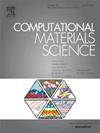A level set approach to modelling diffusional phase transformations under finite strains with application to the formation of [formula omitted]
IF 3.1
3区 材料科学
Q2 MATERIALS SCIENCE, MULTIDISCIPLINARY
引用次数: 0
Abstract
This paper presents a sharp interface formulation for modelling diffusional phase transformations. Grain boundary motion is, in accordance with diffusional phase transformation kinetics, determined by the amount of flux towards the interface and is formulated in a level set framework. This approach enables a computational efficiency that can be expected to be higher than what can be achieved with conventional phase field methods. Compatibility of the interfaces is obtained through an interface reconstruction process, in which the locations of triple junction points are also determined. To ensure local equilibrium and a continuous chemical potential across the interfaces, the chemical composition is prescribed at the phase interfaces. The presented model is used to study the growth of the intermetallic compound (IMC) for a system with Sn electroplated on a Cu substrate. A finite strain formulation is incorporated into the model to investigate the effects of the volume change resulting from the IMC formation. In this formulation, the Cu and Sn phases are allowed to deform plastically. The numerical simulations demonstrate IMC growth rates in agreement with experimental measurements. Moreover, the IMC evolves into a scallop-like morphology, consistent with experimental observations.模拟有限应变下扩散相变的水平集方法,并应用于[公式省略]的形成
本文提出了一种用于模拟扩散相变的尖锐界面公式。根据扩散相变动力学,晶界运动由流向界面的通量决定,并在水平集框架内进行表述。这种方法的计算效率可望高于传统相场方法。界面的兼容性是通过界面重建过程获得的,在这个过程中还确定了三重交界点的位置。为确保局部平衡和跨界面的连续化学势,在相界面处规定了化学成分。该模型用于研究铜基板上电镀锡的金属间化合物(IMC)的生长过程。模型中加入了有限应变公式,以研究 IMC 形成所产生的体积变化的影响。在该公式中,允许铜相和锡相发生塑性变形。数值模拟结果表明,IMC 增长率与实验测量结果一致。此外,IMC 演化成扇贝状形态,与实验观察结果一致。
本文章由计算机程序翻译,如有差异,请以英文原文为准。
求助全文
约1分钟内获得全文
求助全文
来源期刊

Computational Materials Science
工程技术-材料科学:综合
CiteScore
6.50
自引率
6.10%
发文量
665
审稿时长
26 days
期刊介绍:
The goal of Computational Materials Science is to report on results that provide new or unique insights into, or significantly expand our understanding of, the properties of materials or phenomena associated with their design, synthesis, processing, characterization, and utilization. To be relevant to the journal, the results should be applied or applicable to specific material systems that are discussed within the submission.
文献相关原料
| 公司名称 | 产品信息 | 采购帮参考价格 |
|---|
 求助内容:
求助内容: 应助结果提醒方式:
应助结果提醒方式:


